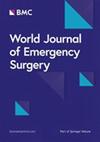优先循环而不是气道以提高出血损伤创伤患者的生存率:世界急诊外科学会-泛美创伤共识声明
IF 5.8
1区 医学
Q1 EMERGENCY MEDICINE
引用次数: 0
摘要
出血是创伤患者可预防死亡的主要原因之一。几十年来,气道-呼吸-循环(ABC)方法一直是创伤护理的基石。然而,新出现的证据表明,在失血患者中优先进行气道管理可能会加重低血压并增加死亡率。本系统综述和荟萃分析旨在评估循环-气道-呼吸(CAB)方法与传统ABC序列相比在提高严重出血创伤患者生存率方面的有效性。根据PRISMA指南进行了系统审查。检索了PubMed和Ovid MEDLINE、SCOPUS、web of science和EMBASE等数据库,检索了截至2024年9月发表的研究。符合条件的研究包括报道出血性出血的创伤患者结局的观察性和比较性研究。采用纽卡斯尔-渥太华量表进行偏倚风险评估。采用随机效应模型进行meta分析,以95%可信区间(CI)计算死亡率的合并优势比(OR)。采用亚组分析比较ABC和CAB方法在前瞻性和回顾性研究中的应用。6项研究(N = 11,855例患者)符合纳入标准。荟萃分析显示ABC方法相关的死亡率显著增加(合并OR: 3.65, 95% CI: 1.74-7.65)。前瞻性队列研究的亚组分析发现,与回顾性研究的POR (POR: 2.42, 95%CI: 1.08-5.36)相比,前者的死亡风险更高(POR: 9.99, 95%CI: 5.59-17.85)。在所有研究中观察到高度异质性(I2 = 92%),可能是由于患者群体和复苏方案的差异。与传统的ABC方法相比,在出血损伤的创伤患者中优先考虑循环而不是气道管理可显著降低死亡率。本共识论文根据WSES方法3进行,旨在对创伤出血患者的CAB方法与传统ABC序列的文献进行综述,以现有证据为基础形成共同的共识声明本文章由计算机程序翻译,如有差异,请以英文原文为准。
Prioritizing circulation over airway to improve survival in trauma patients with exsanguinating injuries: a world society of emergency surgery-panamerican trauma consensus statement
Hemorrhage is one of the leading causes of preventable death in trauma patients. For decades, the Airway-Breathing-Circulation (ABC) approach has been the cornerstone of trauma care. However, emerging evidence suggests that prioritizing airway management in exsanguinating patients may worsen hypotension and increase mortality. This systematic review and meta-analysis aim to evaluate the effectiveness of the Circulation-Airway-Breathing (CAB) approach compared to the traditional ABC sequence in improving survival in trauma patients with severe hemorrhage. A systematic review was conducted in accordance with the PRISMA guidelines. Databases including PubMed and Ovid MEDLINE, SCOPUS, web of science and EMBASE were searched for studies published up to September 2024. Eligible studies included observational and comparative studies reporting outcomes of trauma patients with exsanguinating hemorrhage. The Newcastle–Ottawa Scale was used for risk of bias assessment. A meta-analysis was performed using a random-effects model to calculate pooled odds ratios (OR) for mortality, with 95% confidence intervals (CI). Subgroup analysis was conducted to compare the ABC and CAB approaches in prospective and retrospective studies. Six studies (N = 11,855 patients) met the inclusion criteria. The meta-analysis revealed a significant increase in mortality associated with the ABC approach (pooled OR: 3.65, 95% CI: 1.74–7.65). Subgroup analysis of prospective cohort studies found an even higher mortality risk (POR: 9.99, 95% CI: 5.59–17.85) when compared with POR of retrospective studies (POR: 2.42, 95%CI: 1.08–5.36). High heterogeneity (I2 = 92%) was observed across the studies, likely due to variations in patient populations and resuscitation protocols. Prioritizing circulation over airway management in trauma patients with exsanguinating injuries significantly reduces mortality compared to the traditional ABC approach. The present consensus paper, conducted according to the WSES methodology3, aims to provide a review of the literature comparing the CAB approach to the traditional ABC sequence in trauma patients with exsanguinating hemorrhage, to develop a shared consensus statement based on the currently available evidence
求助全文
通过发布文献求助,成功后即可免费获取论文全文。
去求助
来源期刊

World Journal of Emergency Surgery
EMERGENCY MEDICINE-SURGERY
CiteScore
14.50
自引率
5.00%
发文量
60
审稿时长
10 weeks
期刊介绍:
The World Journal of Emergency Surgery is an open access, peer-reviewed journal covering all facets of clinical and basic research in traumatic and non-traumatic emergency surgery and related fields. Topics include emergency surgery, acute care surgery, trauma surgery, intensive care, trauma management, and resuscitation, among others.
 求助内容:
求助内容: 应助结果提醒方式:
应助结果提醒方式:


